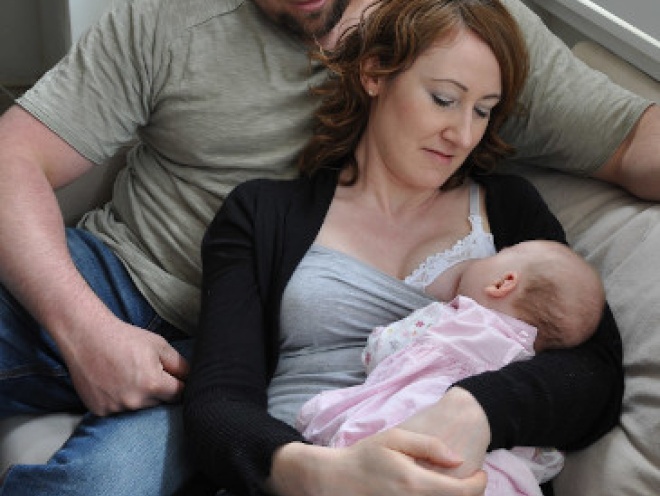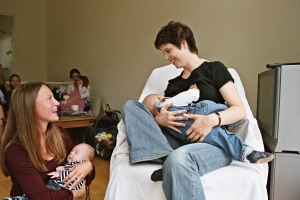Many mums and babies use laid-back breastfeeding straight after birth but it has many benefits even after that first snuggle. Here’s how…
What is laid-back breastfeeding or biological nurturing?
Laid-back breastfeeding is where you to use a comfortable, reclined position to feed your baby. It’s really a relaxed approach where breastfeeding is seen as a relationship between you and your baby, with no need to follow a series of instructions.
Laid-back breastfeeding is also known as biological nurturing or the natural breastfeeding position (Colson, 2003).
What are the benefits of laid-back breastfeeding?
Laid-back breastfeeding:
- Helps to release your baby’s many feeding reflexes.
- Encourages high levels of the nurturing hormone oxytocin in both you and your baby, helping you both to learn how to breastfeed together.
- Uses gravity, which helps to support your baby as they lie on your body, giving them the freedom to use their instinctive feeding behaviour. Gravity also helps your baby to latch more effectively as they’re able to use their natural reflexes, so you’re less likely to get sore nipples.
- Uses skin-to-skin contact, although it also works well when you’re wearing a thin layer of clothing or whatever you’re comfortable in.
- Many mums say laid-back breastfeeding helps them to bond with their baby and get to know them sooner. That’s because laid-back breastfeeding encourages mums to spend lots of time with their baby in the laid-back position even when their babies are not hungry or feeding.
- Can be used at any time - it’s about you feeling comfortable and well-supported, and finding whatever position feels right for you and your baby.
(Colson, 2008, 2012, 2019)
Laid-back breastfeeding: how your newborn latches on
Mums and babies most commonly use laid-back breastfeeding in the hours after birth. This is when your baby may spend time lying tummy-to-tummy with you.
In this period of close contact, you might notice your baby wriggling, pushing with their feet, and moving their head from side to side on your chest. These are primitive feeding reflexes, and you are helping your baby to use these to find your breast (Vinall, 2015; UNICEF, 2019).
Laid-back breastfeeding after a caesarean
Laid-back breastfeeding is useful following a caesarean birth, or in any situation where it’s difficult to sit comfortably upright. That’s because it allows for you to find your own relaxed and supported position (Colson, 2019). If it’s hard to move or lift your baby, ask someone to help you both to get comfortable.
Continuing with laid-back breastfeeding
As your baby learns to breastfeed, they’ll probably adapt easily to different positions, making laid-back breastfeeding very flexible, whether you’re at home or out of the house.
If you’re finding breastfeeding difficult, uncomfortable or painful, the laid-back breastfeeding approach can often help and breastfeeding counsellors use it widely (Vinall, 2015). To find your nearest breastfeeding counsellor or support group, call our Infant Feeding Support line on 0300 3300 700.
How to do laid-back breastfeeding in public
Laid-back breastfeeding doesn't have to be a very reclined or exposing position. In fact, you can sit in any comfortable, slightly reclined position, much in the same way as you might on a sofa or a deep chair.
Many coffee shops, for example, have soft chairs and sofas that would be suitable for laid-back breastfeeding in public. You could also use a changing bag or your coat to support you when you recline if you’re out and about.
Your baby can be more diagonal than if you were reclined right back. You only need to be wearing loose enough clothing to allow your baby access to your breast, to sit in comfort with your friends and enjoy being out of the house.
Tips: laid-back breastfeeding and helping your baby latch on
- Lean back if you’re sitting or recline on any supportive surface. But do not lie flat on your back. It’s okay to adjust your position until it feels right.
- Hold your baby close so they’re lying on your tummy with their core fully supported. If you’ve had a caesarean birth, you might want to place your baby to one side – away from your scar.
- There should be constant contact between you but you don’t need to put pressure on their neck or back. As you relax into the chair or bed, your baby relaxes into your body.
- In this position, your baby’s feet and legs will brush against your body, and usually find something to push against (such as your leg/hand/the bed/your partner’s hand).
- You will notice them nuzzling their face or bobbing their head from side to side until they locate the breast, then open their mouth wide as they latch on. As his or her mouth finds the breast, his sucking reflex starts to work.
The great thing is, you can use laid-back breastfeeding whenever you like, for as long as you like. And just remember – cuddles will not spoil your baby (Unicef, 2018).
This page was last reviewed in October 2019.
Further Information
Our support line offers practical and emotional support with feeding your baby and general enquiries for parents, members and volunteers: 0300 330 0700.
We also offer antenatal courses which are a great way to find out more about birth, labour and life with a new baby.
Make friends with other parents-to-be and new parents in your local area for support and friendship by seeing what NCT activities are happening nearby.
Colson S. (2003) Cuddles, biological nurturing, exclusive breastfeeding and public health. Journal of the Royal Society for the Promotion of Health. 123(2):76–77. Available at: https://doi.org/10.1177/146642400312300206 (accessed 22nd October 2019)
Colson S. (2019) Biological Nurturing – Instinctual Breastfeeding 2nd Edition. Pinter & Martin, London.
Colson S, Meek JH, Hawdon JM. (2008) Optimal positions for the release of primitive neonatal reflexes for early breastfeeding. Early Human Development. 84:441-449
Colson S, DeRooy L, Hawdon J. (2003) Biological nurturing increases breastfeeding duration. MIDIRS Midwifery Digest.13(1):92-97.
Rosin SI. (2019) A Case Study of Biological Nurturing. Journal of Human Lactation. 35(2): 318–322. Available at: https://doi.org/10.1177/0890334419829044 (accessed 22nd October 2019)
UNICEF. (2018) The Baby Friendly Initiative building a happy baby: a guide for parents. Available at: https://www.unicef.org.uk/babyfriendly/wp-content/uploads/sites/2/2018/04/happybaby_leaflet_web.pdf (accessed 22nd October 2019)
UNICEF. (2019) Meeting your baby for the first time. Available at: https://www.unicef.org.uk/babyfriendly/baby-friendly-resources/relationship-building-resources/meeting-baby-for-the-first-time-video/ (accessed 22nd October 2019)
Vinall R. (2015) The value of introducing laid-back breastfeeding Perspective. Dec 2015. Available at: https://www.nct.org.uk/sites/default/files/related_documents/Vinall%20The%20value%20of%20introducing%20laid-back%20breastfeeding_0.pdf (accessed 22nd October 2019)








